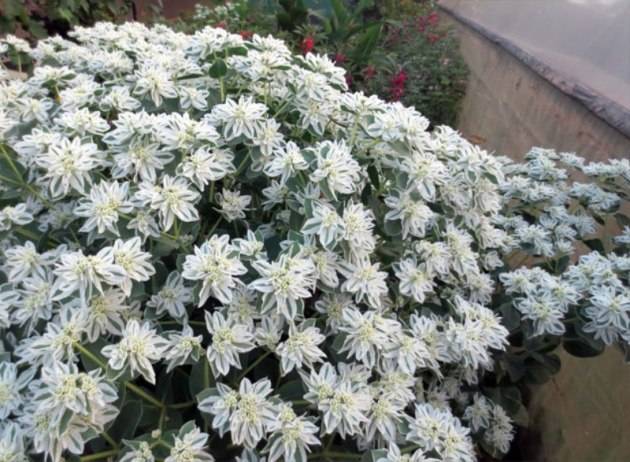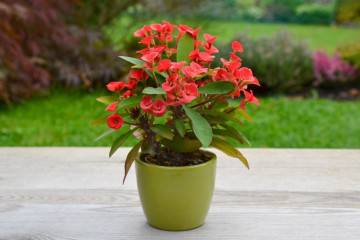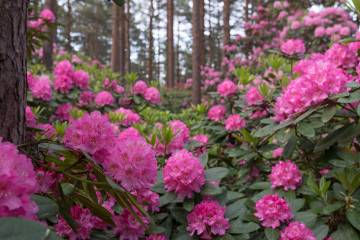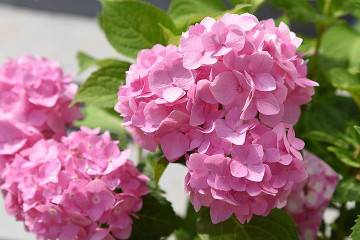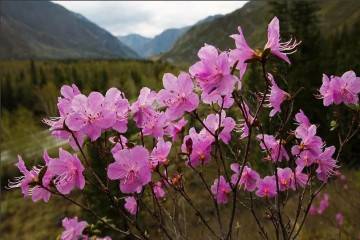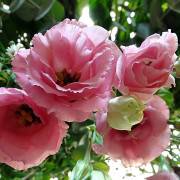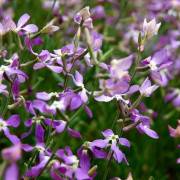Euphorbia Bordered - features of care
Content:
Small flowers of Bordered Milkweed are a real find for gardeners who care about the beauty of the garden. This look will look great on any flower bed and will fit into a variety of designs. Euphorbia fringed perfectly complements bouquets of all flowers, after cutting it can stand in water for up to two weeks. This is another distinguishing feature for which the flower is valued. In addition, the spurge does not require special care and multiplies and grows easily. The plant blooms for only one year, after which it is simply removed.
What does the euphorbia bordered look like, which family it belongs to
The scientific name is Euphorbia marginata. Euphorbia is an annual grass-like shrub that belongs to the Euphorbia family. The plant reaches a height of 50-80 cm. Branched bush with straight stems, which are completely covered with oval-shaped leaves. The leaves are about 4 cm of pale green color, which over time begin to border white stripes. The flowers of the plant are small and dim, surrounded by bracts with white edges. Because of this color scheme, the spurge is called a winter carpet, as it creates the illusion of snow.
Under natural conditions, the shrub grows on mountain slopes, which, due to the external features of flowers, look like snowy hills. Mountain spurge is native to North America. The plant was domesticated in the 19th century. Since then, the shrub has become one of the favorites of landscape designers. They are diluted with various flower arrangements in any territory.
Features of flower care
Gardeners have chosen this variety because of its unpretentiousness. The plant does not require special attention and control, while it looks great on the site both alone and among other flowers.
At home, the flower is rarely grown. In most cases, it is planted in garden plots in open ground. In order for the plant to grow actively, it is necessary to follow the mandatory recommendations for planting and caring for this variety of flowers.
Temperature
The ideal temperature for the growth and flowering of edged milkweed is above 20 degrees. Therefore, this plant is most common in areas with a mild and warm climate.
In the northern regions of Russia, spurge is the least common due to unstable and low temperatures. The middle zone of the country is also not very suitable for the cultivation of milkweed, but nevertheless, several varieties can be found in some areas.
Lighting
The light mode corresponds to the thermal one. For active growth and flowering, it is best to choose places with sufficient light - the sunny side. In the absence of suitable territory, partial shade is allowed. At the same time, an important requirement is the absence of a draft.
Watering
The warm and arid climate is great for milkweed. The bush tolerates a lack of moisture much better than an excess of it. For this reason, moderate watering in the evening with room temperature water is recommended. If the temperature is elevated, you can add spraying to the plant, but in most cases this is not required.
Priming
Euphorbia can grow on any soil: sand or rocky ground, even in mountainous areas. But the more nutritious and saturated the land, the more intensively the shrub will grow. At the same time, it is not necessary to specially prepare and feed the soil before planting.
Top dressing
Like most flowers, edged euphorbia needs seasonal feeding. For fertilization, organic and mineral fertilizers are used. An excellent option would be a manure solution. It is best to feed the shrub in the evening so that the fertilizer is better absorbed into the soil. When preparing the solution, the proportions are adhered to: 200 grams of manure per 10 liters of water.
When and how it blooms
Euphorbia enters the flowering phase in July and pleases the eye until the first frost. The flowers are small, white. A distinctive feature of the plant is that during the flowering period a white border appears on the upper leaves. Because of this color, the whole plant seems snow-white, and gardeners often call euphorbia early snow.
Pruning
After the flowering period, the plant should be removed from the soil. The entire ground part is cut off, and only the roots are removed. It is best to prune the plant with pruning shears and using additional protection for the skin of the hands.
How spurge-bordered euphorbia reproduces
The plant reproduces in two ways: vegetative and seed. Euphorbia fringed responds positively to growing from seed.
Seeds
Seeds are planted directly in open ground either in May or in February-March. In the latter case, it is called before winter. The first shoots will appear within a week, in some cases after 10 days. After the air temperature in spring is already stable and frosts are not expected, the seedlings are planted in a permanent place.
Cuttings
Propagation by cuttings is also possible for milkweed. Shoots are taken from an adult and healthy plant and placed in warm water. Roots will appear in a few days. Immediately after this, the cuttings can be planted in open ground. When planting in open soil, the roots should not be deepened too much. The distance between the shoots is up to 30 cm.
Planting the edged milkweed
Since the plant is annual, reproduction and planting for it is practically the same. It is necessary to plant flowers in spring, February is allowed.
The shrub is planted:
- seeds;
- cuttings.
Before sowing seeds, you need to prepare the soil. It is necessary to dig up the earth and remove all weeds, prepare small holes. Carefully place seeds in each hole. After 1-2 weeks, the first shoots will appear.
Podwinter sowing is allowed, which is also carried out by seeds in February-March. Flower seeds are sown at home. Prepare the soil for seedlings. Seeds are laid out in a pot, with a depression of 2-4 cm.
With the right choice of place and temperature, the first shoots will appear in a few days. When the first leaves appear, each sprout is transplanted into a separate container. Flowers are planted in a permanent place after stable freezing temperatures appear on the street.
You can grow an annual shrub by cuttings. If there is an adult plant, healthy shoots are taken from it and placed in warm water for a day. A day later, the shoot is transferred to peat soil. After a month, the cutting will finally take root and can be transplanted into open ground.
Possible growing problems and diseases
Another of the positive features of edged milkweed is its resistance to pests and diseases. The most destructive for a plant is excess moisture.Resistance to pests is explained by the fact that this plant is poisonous, and insects die from the sap of the flower.
Due to its unpretentious characteristics, Euphorbia is very popular with gardeners. The plant does not require careful maintenance, after cutting it can stand in a bouquet for 2 weeks. This flower will decorate any area with its appearance. The seeds can be purchased at any specialty store.
